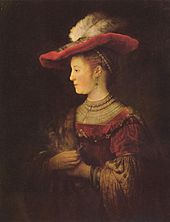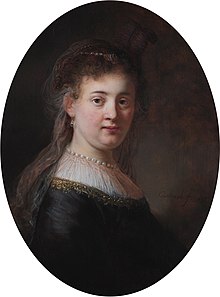Saskia van Uylenburgh

by Rembrandt van Rijn, oil on wood, Gemäldegalerie Alte Meister, Kassel
Saskia Uylenburgh (born August 2, 1612 in Leeuwarden , † June 14, 1642 in Amsterdam ) was the wife of the important Dutch baroque painter Rembrandt van Rijn .
Life
Saskia Uylenburgh was a patrician daughter from Leeuwarden , the capital of the Dutch province of Friesland . Her father Rombertus Uylenburgh (1554-1624), the former mayor of the city, belonged to the political elite of the largely autonomous province, her mother Sjoukje Aessinga (1564-1619) came from a respected Frisian family. Saskia was the youngest of eight children. Her siblings took care of her after she became an orphan at age twelve. In 1628 her brother-in-law Gerrit van Loo (approx. 1580–1641), the husband of her sister Hezekiah, became her guardian. She moved to live with him in the village of Sint Annaparochie in the coastal area of Het Bildt , where van Loo was the community secretary. In 1632 the family and Saskia fled to Leeuwarden because of a peasant uprising.
From there, Saskia probably started a trip to Amsterdam in the spring of 1633 , where several family members lived. She probably lived there with her older cousin Aeltje Uylenburgh and her husband, the preacher Johannes Sylvius. In the studio of her cousin Hendrick van Uylenburgh , a leading art dealer, she must have met his employee Rembrandt van Rijn at that time. On June 5, 1633, she became engaged to him in Friesland. Three days later he captured it in the so-called silver pen portrait, which is now in the Berlin Kupferstichkabinett . He then traveled back to Amsterdam - more than a year passed before the wedding. During this time Saskia moved to Franeker , where her sister Antje had died and her husband, Prof. Johannes Maccovius, urgently needed help. The marriage to Rembrandt was registered in Amsterdam on June 22, 1634. The church wedding took place on July 2, 1634 in Sint Annaparochie in Friesland. Then Rembrandt moved with her to Amsterdam, where they initially lived in Hendrick Uylenburgh's house.
In 1635 Rembrandt ended his collaboration with Uylenburgh and also gave up his apartment. The couple now moved into the house at Nieuwe Doelenstraat No. 20. On December 15, 1635, Saskia's first child was baptized Rombertus, but the little boy only lived two months. Two other children of Saskia, two girls named Cornelia, died in 1638 and 1640 after just a few weeks.
In 1638 Rembrandt sued Saskia's relatives Albertus van Loo and his sister, because they should have said that Saskia had "wasted her parents' inheritance with pomp and splendor". Rembrandt countered that he and his wife were "abundant and wealthy beyond measure". He lost the process.
The next year he bought a house in the Sint Anthoniesbreestraat (today: Jodenbreestraat), today's Rembrandthuis, for the enormous sum of 13,000 guilders . Saskia's fourth child Titus van Rijn was born here in 1641 . Titus was the only one of her children to survive, but Saskia's health deteriorated. It is believed that she suffered from tuberculosis . On June 5, 1642, she made her will, stating that Rembrandt would have to immediately transfer half of their joint property to Titus in the event of remarriage. Should Titus die, Saskia's inheritance would go to relatives. This determination may have influenced Rembrandt in his decision never to marry again. On June 14th, Saskia died at the age of almost 30 and was buried in the Oude Kerk , the city's most distinguished church.
The fact that Saskia fell in love with an artist who was clearly below her as a patrician daughter in the social hierarchy, and then, in spite of all conventions, got a quick engagement, testifies to an unadapted personality and a distinct will of his own.
Significance for Rembrandt's art
Saskia was a source of inspiration for Rembrandt. She was a model for paintings like Saskia as Flora and drawings , but never for a conventional portrait. She always appeared in a role - as a goddess, legendary figure from classical mythology or a biblical female figure. The American art historian Stephanie S. Dickey speaks of a “union of love, art and commerce” in this context. Of particular interest is the large double portrait in the Old Masters Picture Gallery in Dresden, which shows Rembrandt in the role of the prodigal son in the brothel and Saskia sitting on his lap as a courtesan. According to the US art historian H. Perry Chapman, this picture should be interpreted as an ironic commentary by Rembrandt on his own social ambitions. In no other portrait, however, did Rembrandt go as far as in the Kassel painting : the rich, ancient robe makes her appear like a figure from a bygone era, removed from the current era, transfigured into another world. Started in the early days of their marriage, he revised it in the year of her death in 1642. The addition of the hat feather can be an indication of the transience of human life, but the plant in her hands appears as a clear sign of the end of life: the thin leaves remind one Most likely to rosemary, which is a sign of marital fidelity, but also of eternal remembrance. In Dutch portraits of the dead he can be found lying on the bedspread or in the hands of the deceased. The Kassel portrait of Saskia thus becomes a private memory picture of Rembrandt's deceased wife.
Saskia van Uylenburgh,
oil on panel, 1633,
Fries MuseumSaskia as Flora ,
oil on canvas, 1634, HermitageSaskia as shepherdess by Govaert Flinck , 1636, Herzog Anton Ulrich-Museum Braunschweig
Saskia van Uylenburgh,
oil on canvas, after 1634, National Gallery of Art, WashingtonFlora,
oil on canvas, 1635, National GalleryRembrandt and Saskia in the parable of the prodigal son,
oil on canvas, around 1635, Staatliche Kunstsammlungen DresdenRembrandt and Saskia,
copper engraving, 1636,
Rembrandthuis
Others
The asteroid Saskia , discovered by Max Wolf in 1900 , was named after Saskia van Uylenburgh.
For the 400th birthday of Rembrandt, Deutsche Post AG issued a postage stamp in 2006 with a painting of the portrait of Saskia van Uylenburgh in rich costume, this was a joint issue with the Netherlands. However, there were copyright issues with the designs and editions.
literature
- Christoph Driessen: Rembrandt and the women . Pustet, Regensburg 2011, ISBN 978-3-7917-2359-4 .
- Tatjana Kuschtewskaja : Martini Rembrandt Harmesz van Rijn and Saskia van Uylenburgh . In: Dies .: Secrets of beautiful women. Famous artists and their models . Grupello Verlag, Düsseldorf 2018, ISBN 978-3-89978-301-8 , pp. 27–34.
Web links
Individual evidence
- ↑ Christoph Driessen: Rembrandt and the women, Regensburg 2011
- ↑ Kupferstichkabinett Berlin
- ↑ Testament of Saskia van Uylenburgh ( page no longer available , search in web archives ) Info: The link was automatically marked as defective. Please check the link according to the instructions and then remove this notice. in the Amsterdam City Archives (Dutch)
- ↑ Former grave site in the Oude Kerk ( page no longer available , search in web archives ) Info: The link was automatically marked as defective. Please check the link according to the instructions and then remove this notice.
- ↑ Christoph Driessen: Rembrandt and the women, Regensburg 2011, p. 100
- ↑ Stephanie S. Dickey: Rembrandt and Saskia: Art, Commerce, and the Poetics of Portraiture, in: Alan Chong / Michael Zell (eds.): Rethinking Rembrandt, Zwolle 2002, pp. 17 ff.
- ^ H. Perry Chapman: Rembrandt's Self-Portraits, A Study in Seventeenth-Century Identity, Princeton 1990, p. 114 ff.
- ^ Online catalog of the Hessen Kassel Museum Landscape
- ^ Saskia van Uylenburgh in Arcadian Costume
- ↑ Rembrand trademark Saskia: Breakdown in the joint trademark of Germany and the Netherlands 2006 by Han Vermeulen 2006 ( memento of the original from March 4, 2016 in the Internet Archive ) Info: The archive link was inserted automatically and has not yet been checked. Please check the original and archive link according to the instructions and then remove this notice.
| personal data | |
|---|---|
| SURNAME | Uylenburgh, Saskia van |
| ALTERNATIVE NAMES | Uijlenburg, Saskia van |
| BRIEF DESCRIPTION | Dutch model and wife of Rembrandt van Rijn |
| DATE OF BIRTH | August 2, 1612 |
| PLACE OF BIRTH | Leeuwarden |
| DATE OF DEATH | June 14, 1642 |
| Place of death | Amsterdam , Holland |











